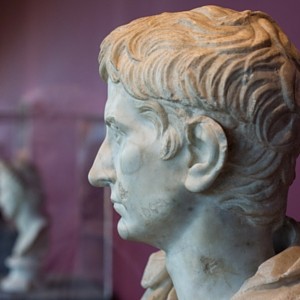NORMAN, OKLAHOMA – It’s not often that an exhibition’s popularity ensures its longevity. However, due to popular demand, officials at the Fred Jones Jr. Museum of Art have announced that an exhibition of Roman busts will remain on display through February 14, 2016.
Immortales: The Hall of Emperors of the Capitoline Museums, Rome brings to the United States for the first time a selection of 20 busts from the collection of the world’s oldest museum, the Capitoline in Rome. The exhibition opened in September and was originally scheduled to close this month at the Fred Jones Jr. Museum of Art on the University of Oklahoma Norman campus.
Record numbers of visitors have prompted the museum and exhibition sponsor Enel Green Power to extend the exhibition’s duration by three months.
“We have been extremely pleased with both the high visitor turnout for Immortales and the excitement surrounding the exhibition,” said Mark White, the museum’s Wylodean and Bill Saxon Director and Eugene B. Adkins Curator. “During the three months of the exhibition so far, our attendance numbers have been the highest on record.”
Immortalesoffers a survey of Roman portraiture from the age of Augustus (1st century, B.C.) to the late Roman Empire (5th century, A.D.). Sculpted busts of emperors, empresses and patricians reveal how portraits helped craft private and public images of distinguished individuals for ancient Roman audiences as well as for posterity.
The exhibition is made possible by the generous support of Enel Green Power North America, a leading owner and operator of renewable energy plants in North America. In Oklahoma, the company owns and operates four wind farms, with two additional wind sites under construction.
“Immortales represents a unique collaboration between the University of Oklahoma, Enel Green Power North America and the Capitoline Museums in Rome,” said White. “This collaboration has culminated in a once-in-a-lifetime opportunity for our visitors – the chance to see ancient Roman busts here in Norman – and we are excited to continue this collaboration by extending the run of the exhibition.”
“We are thrilled that already so many from the community have enjoyed this special exhibit and we are excited to be part of its continuation,” said Rafael Gonzalez, chief executive officer of Enel Green Power North America. “The Hidden Treasures of Rome, which combines ancient artistic culture with some of the world’s leading research universities, is a one-of-a-kind opportunity that enables community engagement with our company, while also cultivating discussion of our shared global history, interests and experiences.”
The exhibit in Oklahoma is the second phase of the Hidden Treasures of Rome program, which was launched in 2014 by Enel Green Power, in partnership with the world-renowned Capitoline Museums of Rome, and served as a first-of-its-kind initiative to exchange cultural, educational and technological resources and artifacts between the Capitoline Museums and U.S. universities.
“The program’s expansion allows the company to bring the ancient culture of Rome to the state of Oklahoma, creating a distinctive exhibit for the university and innovative way for the company to engage with local residents and communities,” Gonzalez said.
Located in the political and religious center of ancient Rome, site of the Temple of Jupiter and overlooking the Forum, the Capitoline Museums, which were erected between the 1200s and the 1400s, sit atop one of the Seven Hills of Rome. In 1471, Pope Sixtus IV inaugurated the collection by donating to the Roman Senate four ancient bronze sculptures with the expressed wish to establish an institution for ancient masterpieces that would testify to his zeal for antiquity. Sixtus’ donation represented the Thesaurus Romanitatis, an invaluable collection treasured by the Church and safeguarded from pillaging throughout the Middle Ages.
Michelangelo later was commissioned with the redesign of the façades of the Palazzo Senatorio and the Palazzo die Conservatori, which, together with the newly erected Palazzo Nuovo (also a project of Michelangelo), enclosed a vast trapezoidal square.
Eventually relocating from the Palazzo dei Conservatori to the Palazzo Nuovo, the Capitoline Museums were established officially in 1734 to the display of the legacy of Imperial Rome. The complete Hall of Emperors in the Palazzo Nuovo contains 67 busts at present, the result of a 19th-century curatorial choice to create a survey of Roman portraiture from the Republican period to the late-Roman empire. Immortales displays 20 works from the Hall of Emperors in the Lissa and Cy Wagner Gallery at the Fred Jones Jr. Museum of Art.
More information about the exhibition is available on the museum’s website atou.edu/fjjma.
The Fred Jones Jr. Museum of Art is located in the OU Arts District on the corner of Elm Avenue and Boyd Street, at 555 Elm Ave., on the OU Norman campus. Admission to the museum is complimentary to all visitors, thanks to the generosity of the OU Office of the President and the OU Athletics Department. The museum is closed on Mondays. Information and accommodations on the basis of disability are available by calling (405) 325-4938 or visiting www.ou.edu/fjjma.



